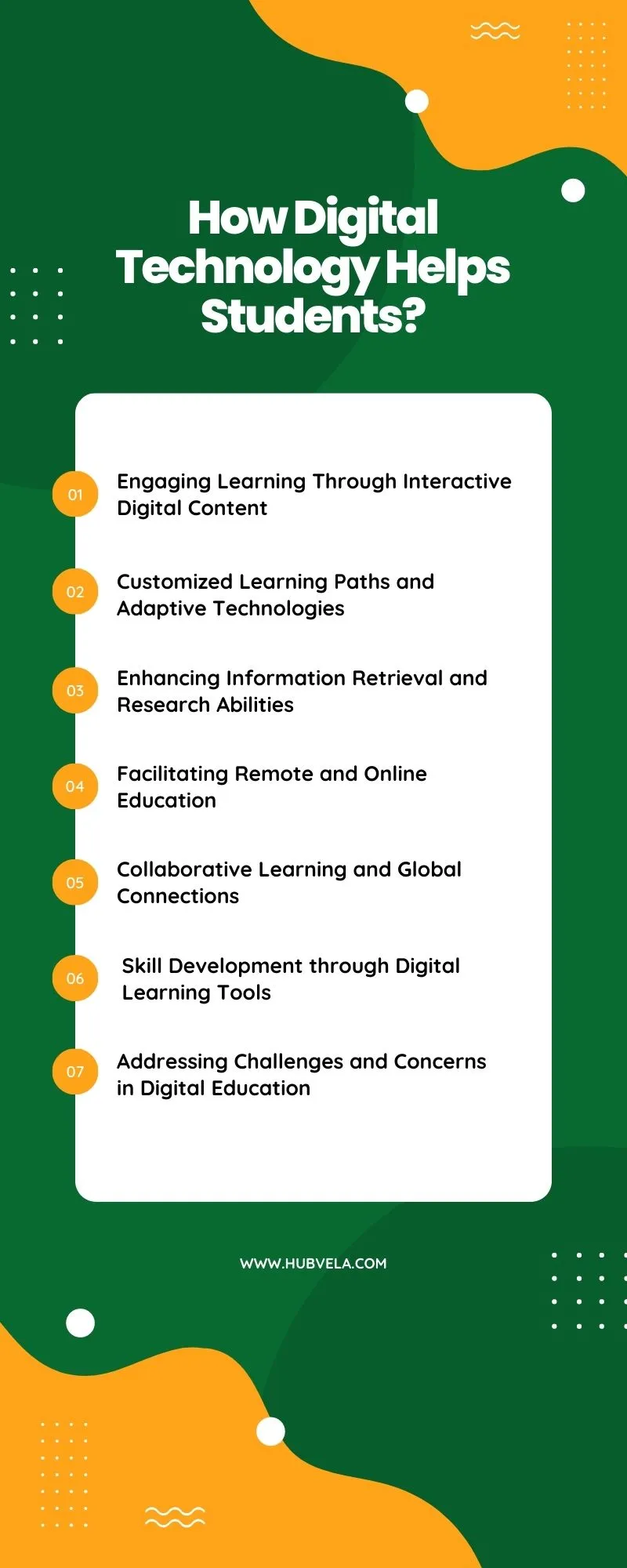Digital technology has become an integral part of modern education, and its benefits for students are numerous. From increased engagement to improved access to information, technology has the potential to transform the way students learn and interact with the world around them.
In this article, we will explore how digital technology can help students, and why adopting a learning strategy that embraces technology in the classroom environment can improve engagement and increase student success rates.

--Advertisement--
How Digital Technology Helps Students? (Infographic)

1. Engaging Learning Through Interactive Digital Content
Digital technology has revolutionized the way students learn by providing interactive and engaging content that can be accessed from anywhere. Here are some ways digital technology can help students learn:
Interactive digital content: Digital content can be interactive and engaging, providing students with a more immersive learning experience. For example, PowerPoint presentations, customizable digital “textbooks,” and pre-made interactive digital experiences.
Applied digital skills: Applied digital skills lessons teach practical digital skills with free video lessons. These interactive lessons come complete with tutorial videos and all of the links and resources your students need to complete the tasks. These lessons are perfect for asynchronous work time during remote learning or in-person teaching if you’re returning to the classroom, and can be assigned directly to Google Classroom.
Project-based learning: Interactive media can be used to boost student engagement in project-based learning. ThingLink is an example of a tool that can be used to create interactive media for project-based learning. It has been shown to increase learning outcomes by 4x compared to standard lecture-based methods.
Gamification principles: Gamification principles can be used to make learning more engaging and fun. For example, teachers can use game-based learning platforms like Kahoot! or Quizlet to create interactive quizzes and games that students can play to reinforce their learning.
Accessible curriculum content: Digital technology can make curriculum content more accessible to students with disabilities. For example, eLearning platforms can provide closed captioning, audio descriptions, and other accessibility features to make learning more inclusive.
2. Customized Learning Paths and Adaptive Technologies
Customized learning paths and adaptive technologies are two approaches that use digital technology to help students learn in a more personalized and effective way.
Here are some ways in which digital technology can help students through customized learning paths and adaptive technologies:
Customized Learning Paths:
Customized learning paths provide students with agency in how they move through course content via choices in format, mode of instruction, pacing, or content selection based on their individual success and needs.
Instructors can use student questioning, interviews, conferencing, observations, shuffling groups, different times to meet/work, and technology to personalize and adapt learning experiences.
Key benefits of customized learning include increased student engagement, motivation, and achievement.
Adaptive Technologies:
Adaptive learning is a technology-based, interactive training method that personalizes learning experiences.
Adaptive learning technology works similarly to a tutor in that it personalizes learning experiences and confronts the learner with their unconscious incompetence.
Adaptive learning technologies take a sophisticated, data-driven, and non-linear approach to instruction and remediation, adjusting to a learner’s interactions and demonstrated performance level and subsequently anticipating what types of content and resources learners need at a specific point in time to make progress.
Adaptive learning systems customize the presentation of the content or present new concepts to the student based on their individual activities and responses.
Benefits of Customized Learning Paths and Adaptive Technologies:
- Personalized learning paths take into account students’ individual preferences and needs, resulting in increased student engagement, motivation, and achievement.
- Adaptive technologies provide personalized learning experiences that are tailored to the individual learner’s needs, resulting in improved learning outcomes.
- Customized learning paths and adaptive technologies can help learners who usually struggle with traditional methods to achieve expected learning outcomes.
Customized learning paths and adaptive technologies are two approaches that use digital technology to help students learn in a more personalized and effective way.
These approaches take into account students’ individual preferences and needs, resulting in increased student engagement, motivation, and achievement.
Adaptive technologies provide personalized learning experiences that are tailored to the individual learner’s needs, resulting in improved learning outcomes.
3. Enhancing Information Retrieval and Research Abilities
Digital technology has revolutionized the way students conduct research and retrieve information. Here are some ways in which digital technology can help enhance information retrieval and research abilities:
Access to vast resources: Digital technology provides students with quick access to a vast world of multimedia resources. Students can access some of the best available research online, especially if they have access to databases and are taught how to use them to do research. This allows students to retrieve accurate, relevant, and up-to-date information stored in electronic documents.
Quick and tangential searches: When students come across the information they don’t understand in the course of the research, the internet allows them to conduct quick, tangential searches to learn needed information in support of their primary search.
Collaboration: Digital technology can facilitate collaboration among students, enabling them to share resources and work together on research projects.
Improved information literacy: Digital technology can help improve students’ information literacy skills, which are essential for conducting effective research. Information literacy skills include the ability to obtain, understand, evaluate, and use information in a variety of digital technology.
4. Facilitating Remote and Online Education
Digital technology has played a crucial role in facilitating remote and online education, making it more widely accessible for everyone. Here are some ways in which digital technology can help students:
Improved Inclusion and Personalization: Online education allows people who work full-time to further their learning remotely in their own time, children who don’t suit traditional schooling can work at their own pace in a safe environment, and people who live an alternative lifestyle due to illness or travel can receive an education.
Access to Devices and the Internet: Before a student can meaningfully engage in digital learning, they need access to a device and the Internet. It is important for teachers to have a current understanding of what technology tools are available, what their school can and does provide, and what families can access.
Quicker and Easier Teaching Tasks: Technology has made certain teaching tasks quicker and easier. For example, a teacher can arrange an online quiz for their students, which will provide them with instant results and feedback. This eliminates the need for the teacher to assess and review each child’s quiz. Educators are also able to use technology to schedule separate group or individual lessons, produce personalized content, and stay in contact.
Reinforcement of Digital Skills: Classroom technology can help reinforce the digital skills students will need to become productive members of society, such as proper online etiquette.
Mitigation of Learning Loss: Digital learning can help mitigate learning loss and create opportunities for social and emotional engagement.
Higher Engagement: Technology in education is a powerful tool that can enrich and improve the education process for both teacher and student.
To make the most of digital technology in remote and online education, teachers should consider the following promising practices for remote digital environments:
- Determine the appropriateness of synchronous and asynchronous learning.
- Use digital tools to create engaging and interactive learning experiences.
- Provide opportunities for social and emotional engagement.
- Use data to inform instruction and personalize learning.
- Foster a culture of digital citizenship and responsibility.
Overall, digital technology has the potential to revolutionize education and make it more accessible and engaging for students.
However, it is important to consider the limitations and challenges of remote and online learning, such as a lack of structure and lengthy response times from teachers.
5. Collaborative Learning and Global Connections
Collaborative learning and global connections are important aspects of education that can be enhanced through the use of digital technology.
Here are some ways in which digital technology can help students in collaborative learning and global connections:
Student-Collaboration Tools: There are various digital tools available that facilitate collaboration among students. These tools allow students to work together on projects, share and receive feedback, brainstorm ideas, and collaborate on creative tasks.
Some examples of student-collaboration tools include Drawp for School, Makers Empire, Breakout EDU, Minecraft: Education Edition, and Popplet.
Promoting Teamwork and Collaboration: Technology can be used to promote teamwork and collaborative projects in the classroom. It allows students to connect with classrooms across the globe, fostering global connections and exposing students to different perspectives and cultures. This helps in developing collaborative skills and preparing students for future work environments where collaboration is essential.
Enhanced Interaction: Digital collaboration technologies in education enhance learners’ interaction in the classroom. Students can engage in online discussions, collaborate on shared documents, and work together on virtual platforms, regardless of their physical location. This promotes active participation and engagement among students, leading to a more dynamic and interactive learning experience.
Cost-Effectiveness and Accessibility: Digital collaboration using technology is cost-effective compared to traditional learning methods. It eliminates the need for physical resources and reduces transportation costs. Digital tools and platforms make education more accessible, allowing students to access information and resources from anywhere at any time.
Facilitating Collaborative Creativity: Digital technology can play a role in promoting collaborative creativity in language education. It can serve as a tutoring device, enabling the development of co-creative thinking skills and creating resourceful environments for collective creative processes.
Various digital platforms, such as audio and video platforms, blogs, web-based environments, and mobile technology, can be used to facilitate collaborative creativity.
Overall, digital technology provides students with opportunities to collaborate, connect globally, and engage in interactive and creative learning experiences.
It enhances collaboration skills, promotes teamwork, and prepares students for the collaborative nature of the modern workforce.
6. Skill Development through Digital Learning Tools
Digital learning tools play a crucial role in skill development for students. These tools leverage the power of digital technology to provide interactive and immersive learning experiences. Here are some ways in which digital learning tools help students:
Increased Engagement: Digital learning tools provide interactive and immersive experiences that can increase student engagement. Features such as multimedia content, gamification elements, real-time collaboration, and interactive assessments help captivate students’ interest and motivate them to actively participate in their learning.
Adaptability: Digital learning tools can be adapted for various educational levels, from K-12 to higher education and professional development. Different tools and platforms cater to specific age groups and learning objectives.
Flexibility: Digital learning tools enable students to learn according to their own schedules. They can access learning materials anytime and anywhere, allowing for flexibility and personalized learning experiences.
Access to a Wide Range of Resources: Digital learning tools provide access to a vast array of resources, including online courses, videos, interactive simulations, and virtual labs. This allows students to explore different topics and gain a deeper understanding of the subject matter.
Collaboration and Communication: Digital learning tools facilitate collaboration and communication among students and teachers.
Features such as discussion forums, online chat, and real-time collaboration tools enable students to work together on projects, share ideas, and receive feedback from their peers and instructors.
Personalized Learning: Digital learning tools often incorporate adaptive learning algorithms that can tailor the learning experience to individual students’ needs. These tools can track students’ progress, identify areas of weakness, and provide personalized recommendations and feedback to help students improve their skills.
Cost-Effectiveness: Digital learning tools can save students a significant amount of money compared to traditional classroom-based learning. Virtual classes and online courses are often more affordable, and students can avoid additional expenses such as commuting and accommodation. Overall, digital learning tools provide students with a dynamic and interactive learning environment that enhances their skills and knowledge.
These tools empower students to take control of their learning, explore new topics, and develop the skills they need for future success.
7. Addressing Challenges and Concerns in Digital Education
Digital education has become increasingly popular in recent years, but there are still challenges and concerns that need to be addressed. Here are some of the key challenges and how digital technology can help students:
Challenges:
Infrastructure: Both schools and students face the challenge of having the necessary technology and internet access to support digital learning.
Resistance to change: Some teachers and students may be resistant to adopting digital learning due to a preference for traditional methods.
Content curation: Digital learning requires dynamic and interactive curated content, which can be time-consuming and costly to produce.
Technological changes: Digital learning requires ongoing updates and maintenance to keep up with technological advancements.
Self-discipline: Students need to be self-motivated and disciplined to succeed in a digital learning environment.
Lack of communication: Digital learning can sometimes lead to a lack of communication between students and teachers.
Poor time management: Students need to manage their time effectively to balance their coursework with other responsibilities.
Conclusion on How Digital Technology Helps Students
In conclusion, digital technology can play a significant role in improving education and learning outcomes for students. It provides students with instant access to a vast amount of information and resources that may not be available in traditional textbooks.
The effective use of digital learning tools in classrooms can increase student engagement, help teachers improve their lesson plans, and ultimately lead to better academic performance.
Technology can help students develop digital skills that are essential in today’s world. However, there are also challenges that come with technology-enabled learning, such as ensuring that every student and educator has access to the necessary devices and software.
It is important for educators to use technology as a tool to support their students’ needs and to foster important dialogues among campus stakeholders regarding technology, diversity, equity, and inclusion, as well as accessibility.
Overall, the potential benefits of technology in education are significant, and with strong vision and leadership at all levels, technology can be used to improve learning for students of all backgrounds and in all places.


